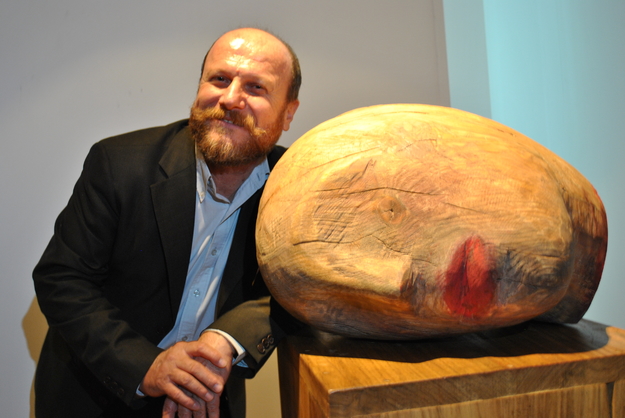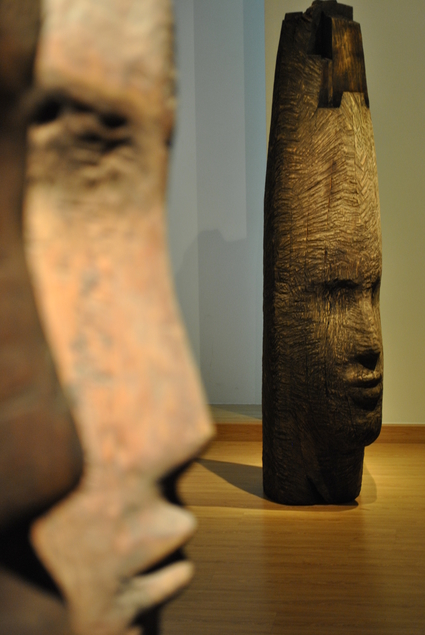Review of exhibition by Reem Maghribi:
Scores of artistically minded Damascus residents attended the opening of Mustafa Ali’s latest exhibition ‘Guillotine’ at Ayyam Gallery Damascus on Saturday evening.
They were there to rub shoulders with the city’s cultural elite, and with the internationally celebrated and recognised Syrian artist Mustafa Ali.
Ali made a name for himself as a sculptor working with wood and metal, though metal does not feature as prominently in these work as in most of his more recognisable pieces housed in galleries, homes and hotels in Syria and far beyond.
Here the artist has focused on presenting the human head in a simple form. Simplicity however is coupled with size - the heads are so large they dwarf the petite artist.
The largest head stands greeting visitors at the street entrance of the gallery. It is simple but grand, and puts you in the mood for what awaits inside.
Ayyam gallery is divided into two rooms. One housed five heads made simply out of wood. Their shapes different, the cuts and strokes used by the artists knife evident and different in each one, each lending itself comfortably to a different corner of the room.
The second room houses four heads, differentiated from those in the first room by the use of paint to highlight the lips and elements of blood.
Given my admiration for Ali’s simple yet sophisticated approach to the use of wood and metal, I was not expecting to see red lips on otherwise effortlessly sculpted heads.
Two heads lay simply on their side - their cheeks - with red lips. A poor expression of femininity I thought at first. Perhaps the artist wished to differentiate between the men in the other room and the women in this one.
Another, with a strong crack in the wood down the woman’s upwardly standing head, was painted along the crack and across the lips. A depiction of blood or femininity, or both?
And most uncharacteristic of the artist’s work, from my perspective, was the large decapitated head presented beside the large axe.
Black paint is used to express the head’s features and red is again used to highlight the lips and spattered across the neckline and knife to highlight what is already evident, that a beheading has taken place.
It is the simplicity of the execution - pardon the pun - of the craftsmanship of the heads in the first room that attract my attention.
They, helped by their placement in corners of a dimly lit room, exude the sense of solitude and poignancy that the exhibition title, ‘Guillotine’, suggests the artist aims to invoke in his audience.
Leaving the exhibition I pass by the gigantic head again. The exhibition has ingrained more questions than I had at first realized. Is the guillotine grand? Is the act of beheading, or being beheaded, magnificent and beautiful, as the simple sophisticated sculptures that stand tall suggest? Or is there an element of the pathetic, as the made up faces of anonymously beheaded women seemed to me to be?
Do these heads honour the dead, or do they highlight their anonymity, their insignificance, their absence.
About Mustafa Ali:
One of the Arab world’s foremost sculptors, Mustafa Ali was born in Lattakia, Syria in 1956.
After studying sculpture at the Faculty of Fine Arts in Damascus, Ali continued his studies at the Fine Arts Academy in Carrara, Italy, graduating in 1996.
A favorite among regional collectors for nearly three decades, his work is housed in private and public collections throughout the Middle East, including a number of official institutions in Syria such as the National Museum and the Museum of Contemporary Art in Damascus, in addition to the Jordan National Gallery in Amman, the Sharjah Museum of Art and the Arab World Institute in Paris.
Although known for elegant, monumental sculptures that pierce the consciousness and underscore the fragility of mankind, Ali is also the director of the renowned Damascus art centre The Mustafa Ali Art Foundation, which presents exhibitions, workshops, lectures and cultural events throughout the year to local artists and the public.

